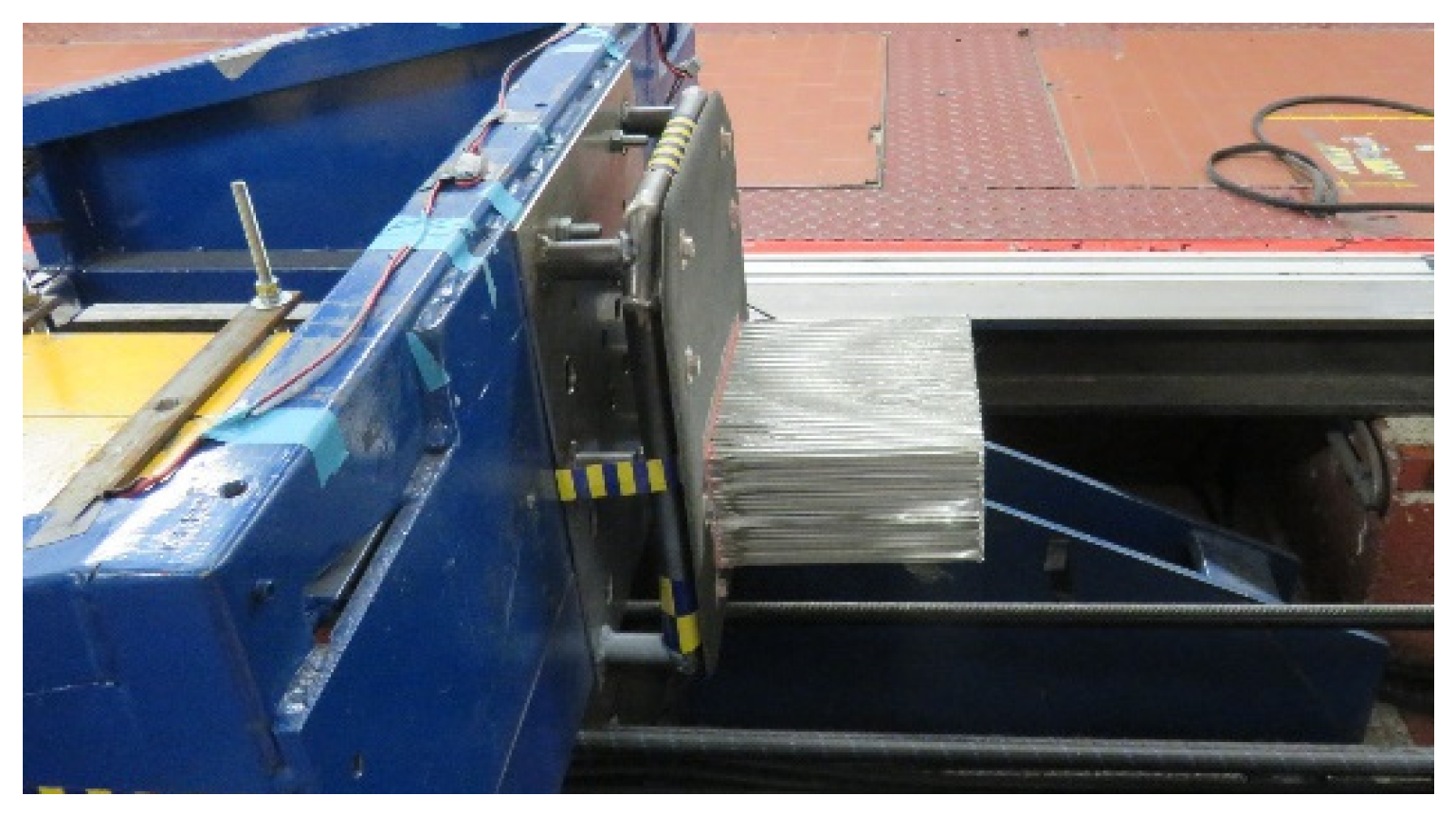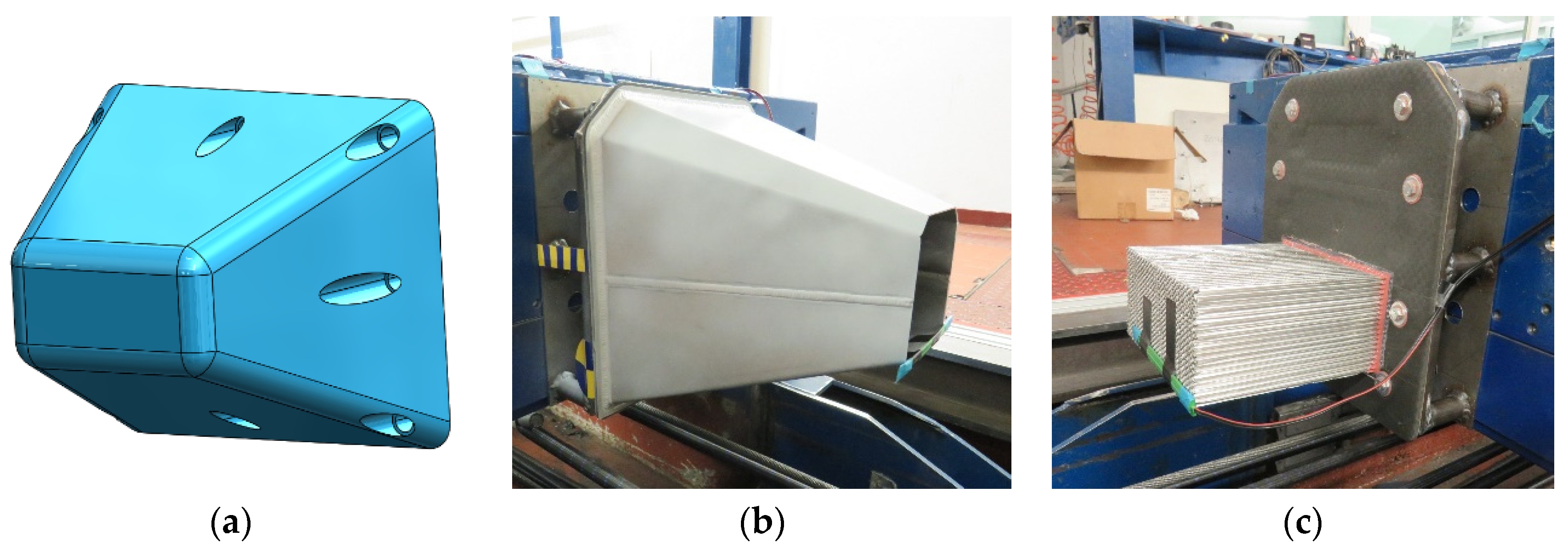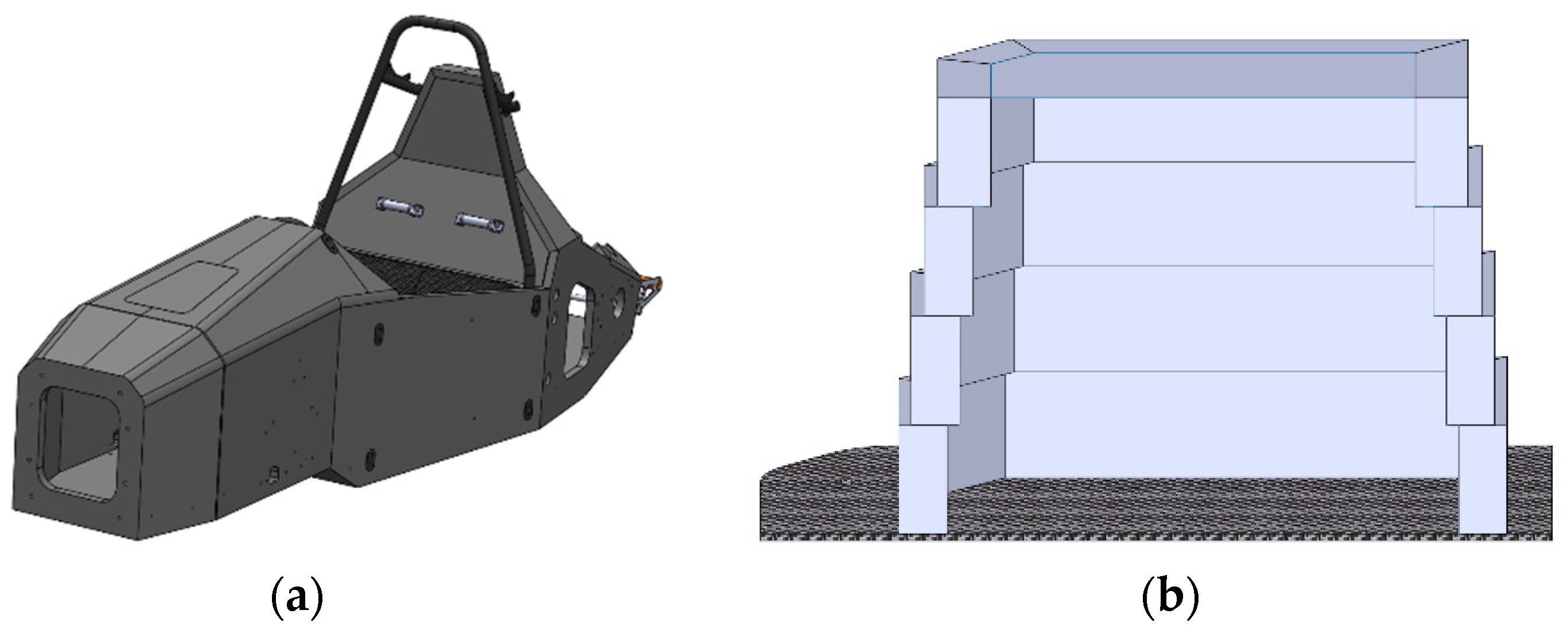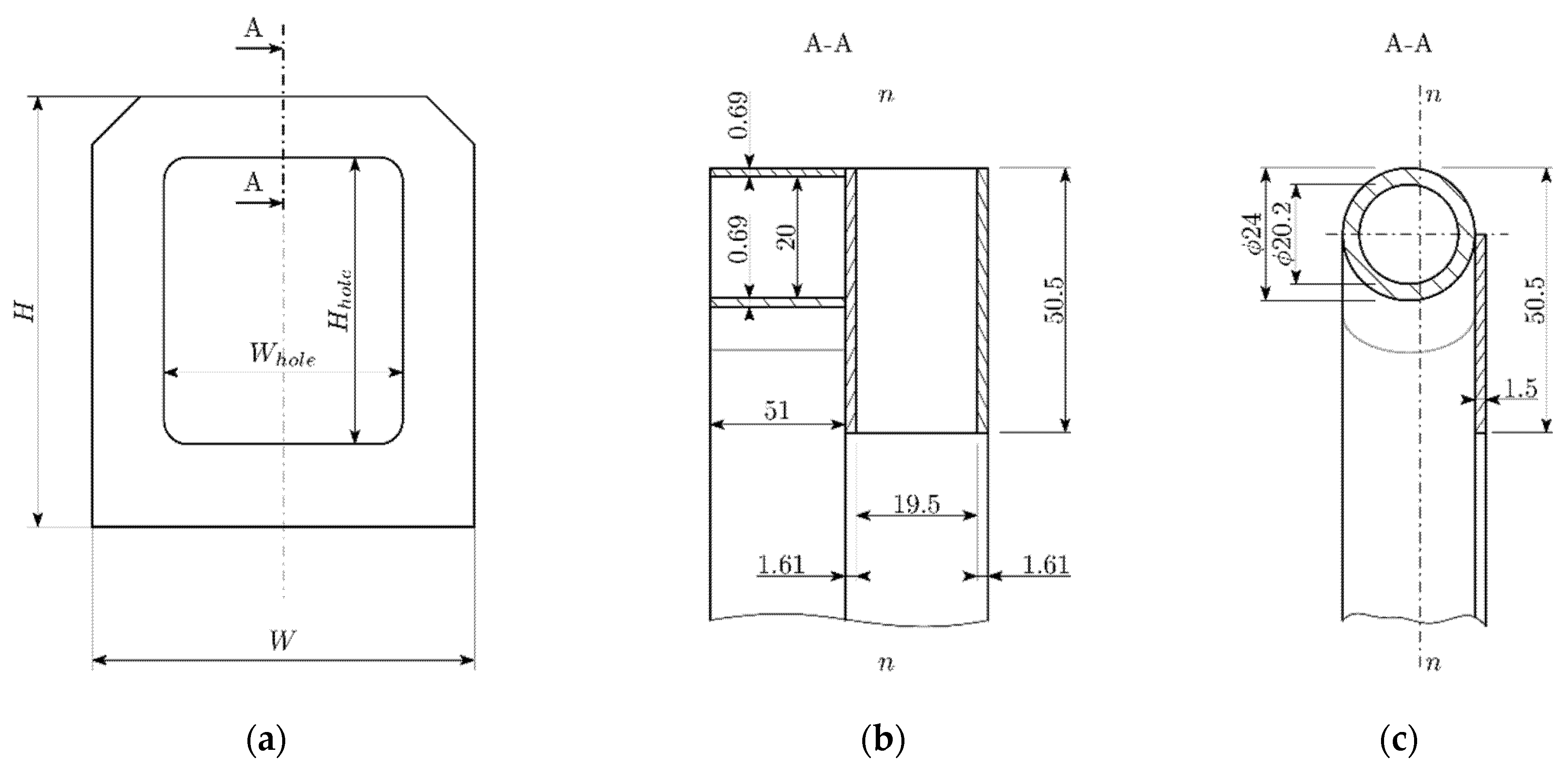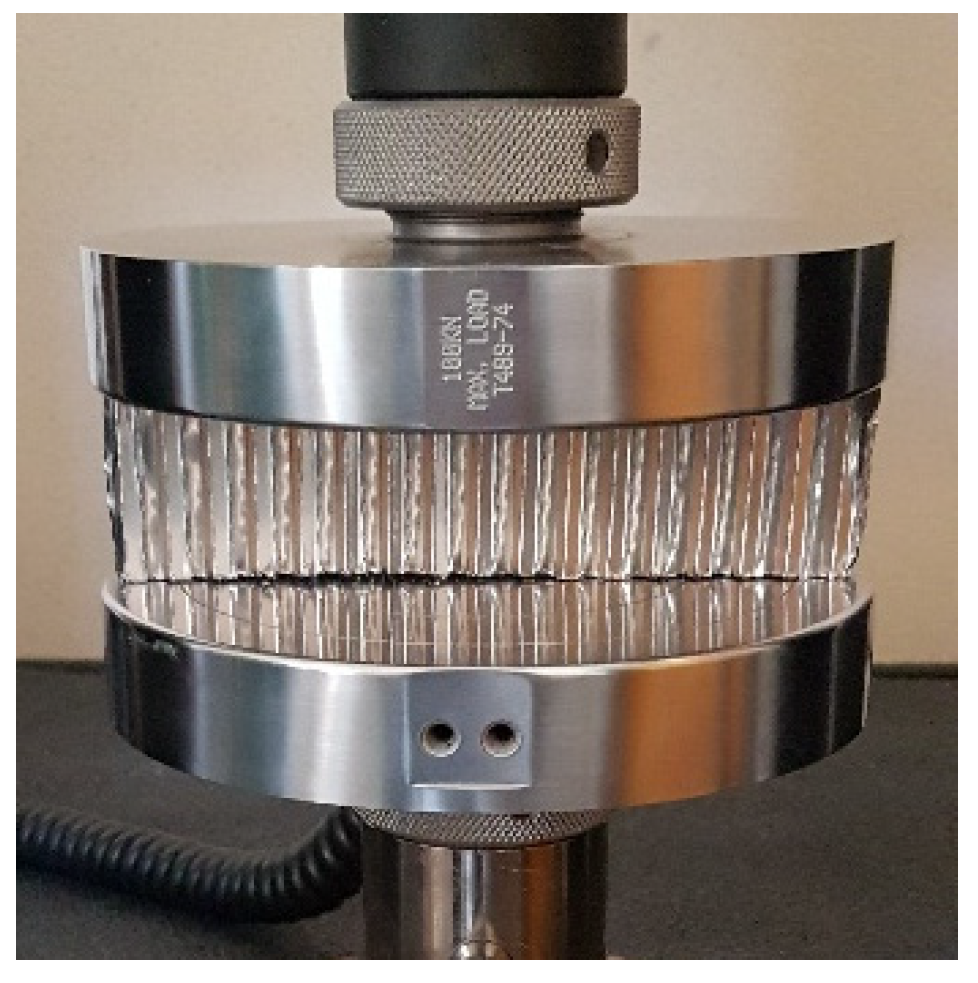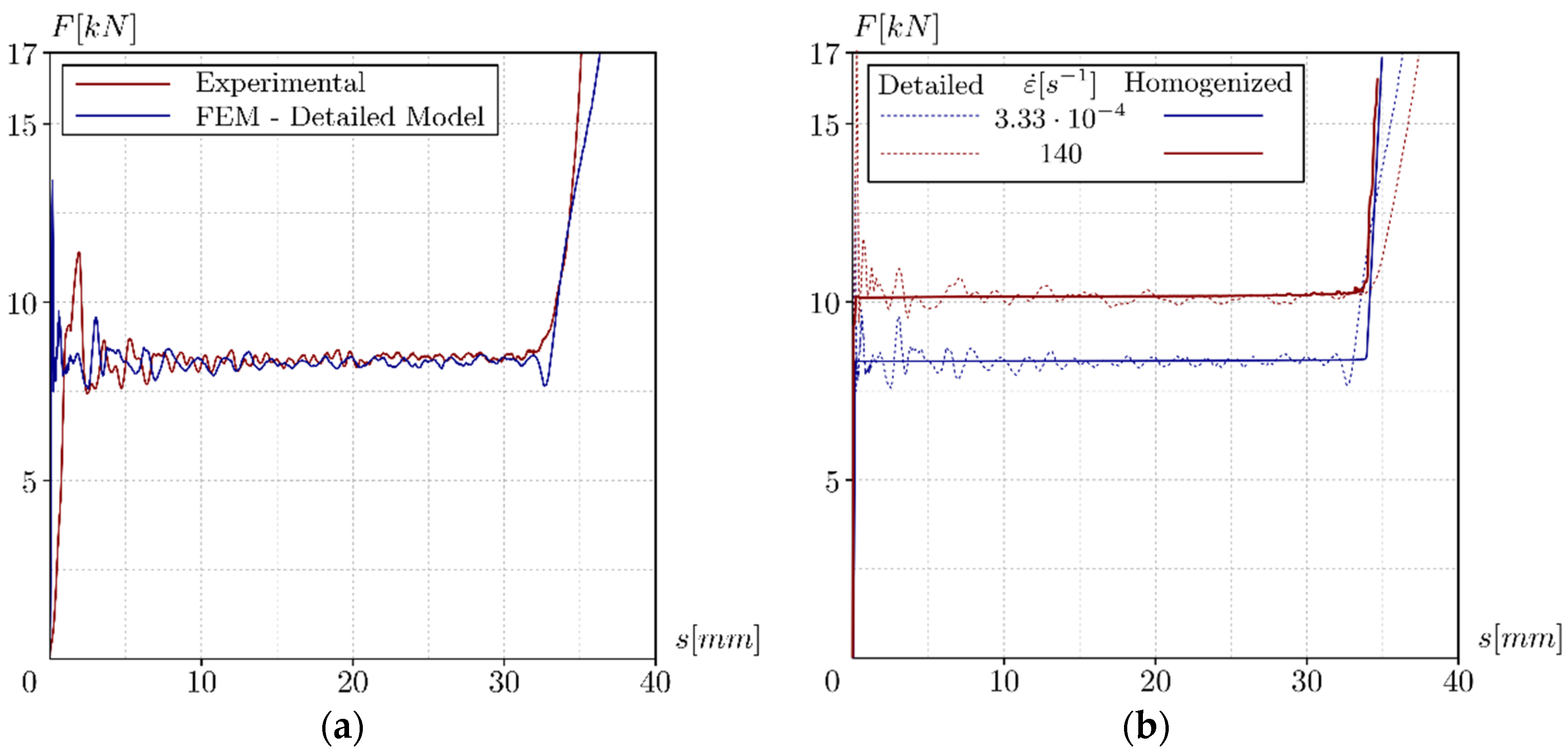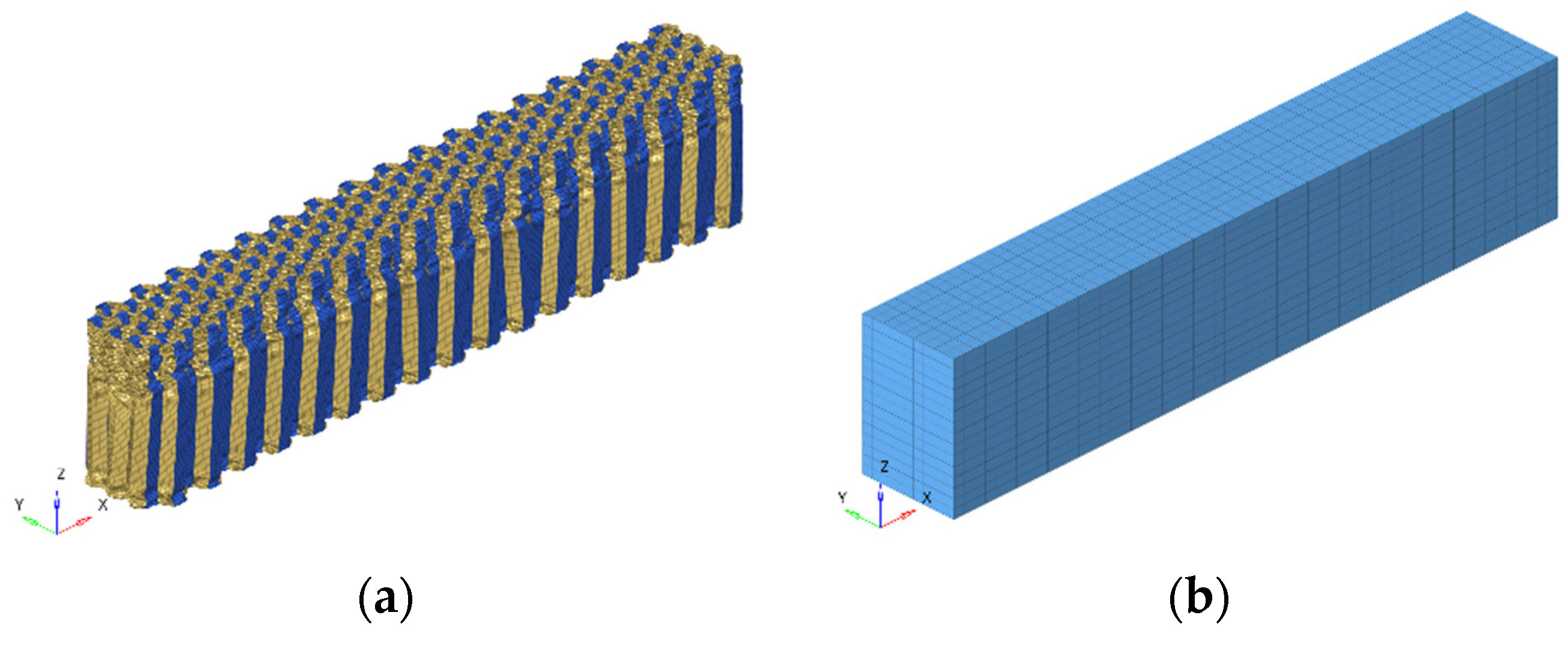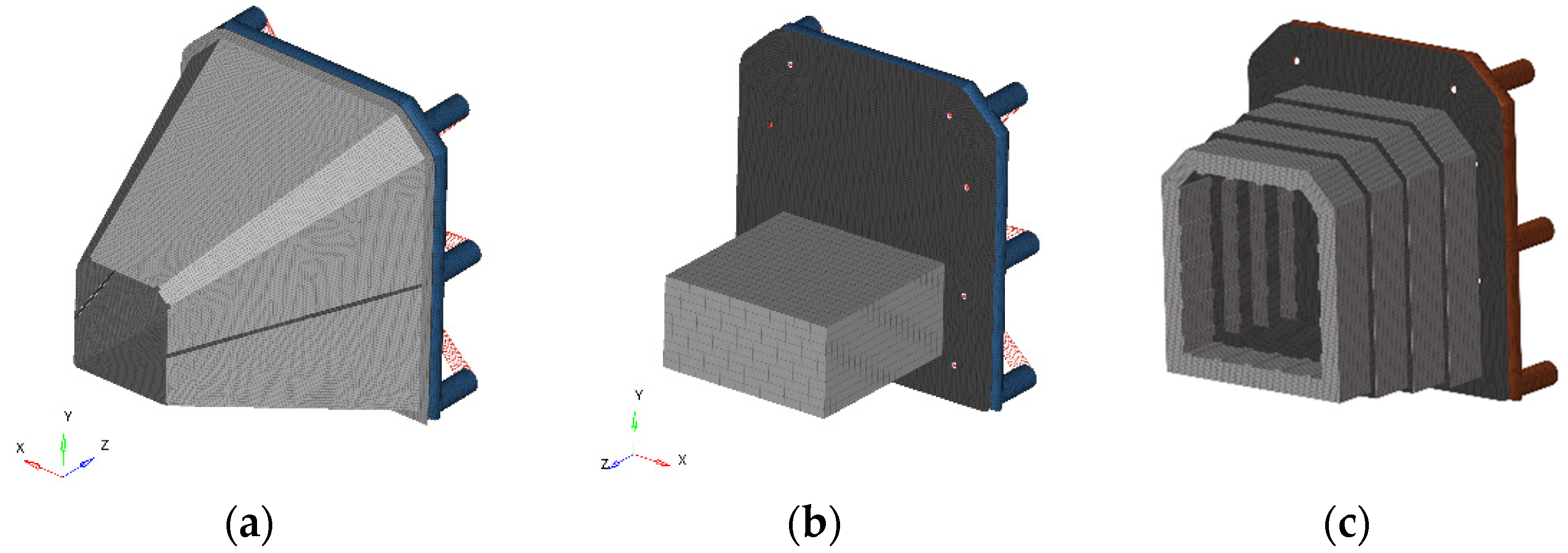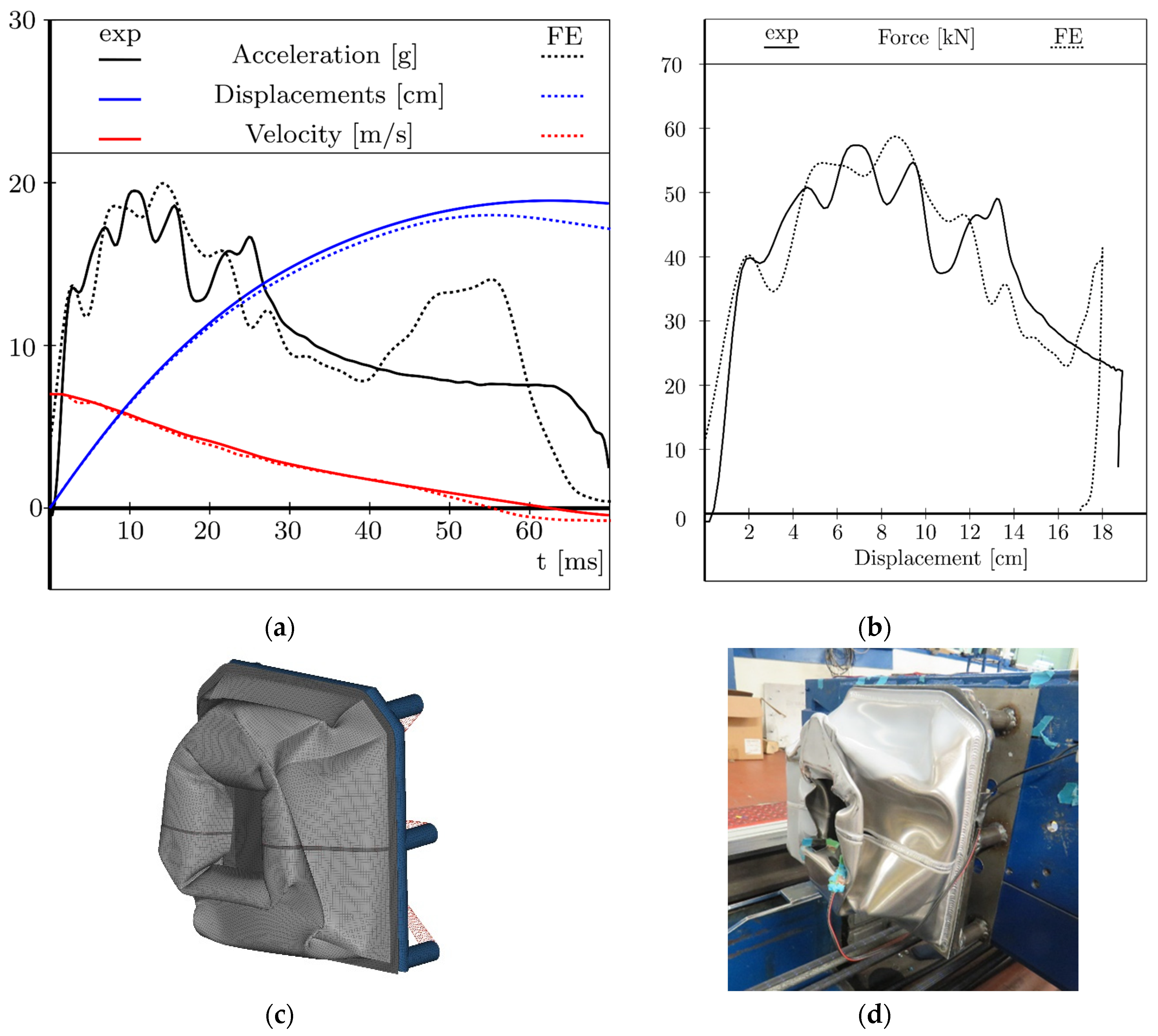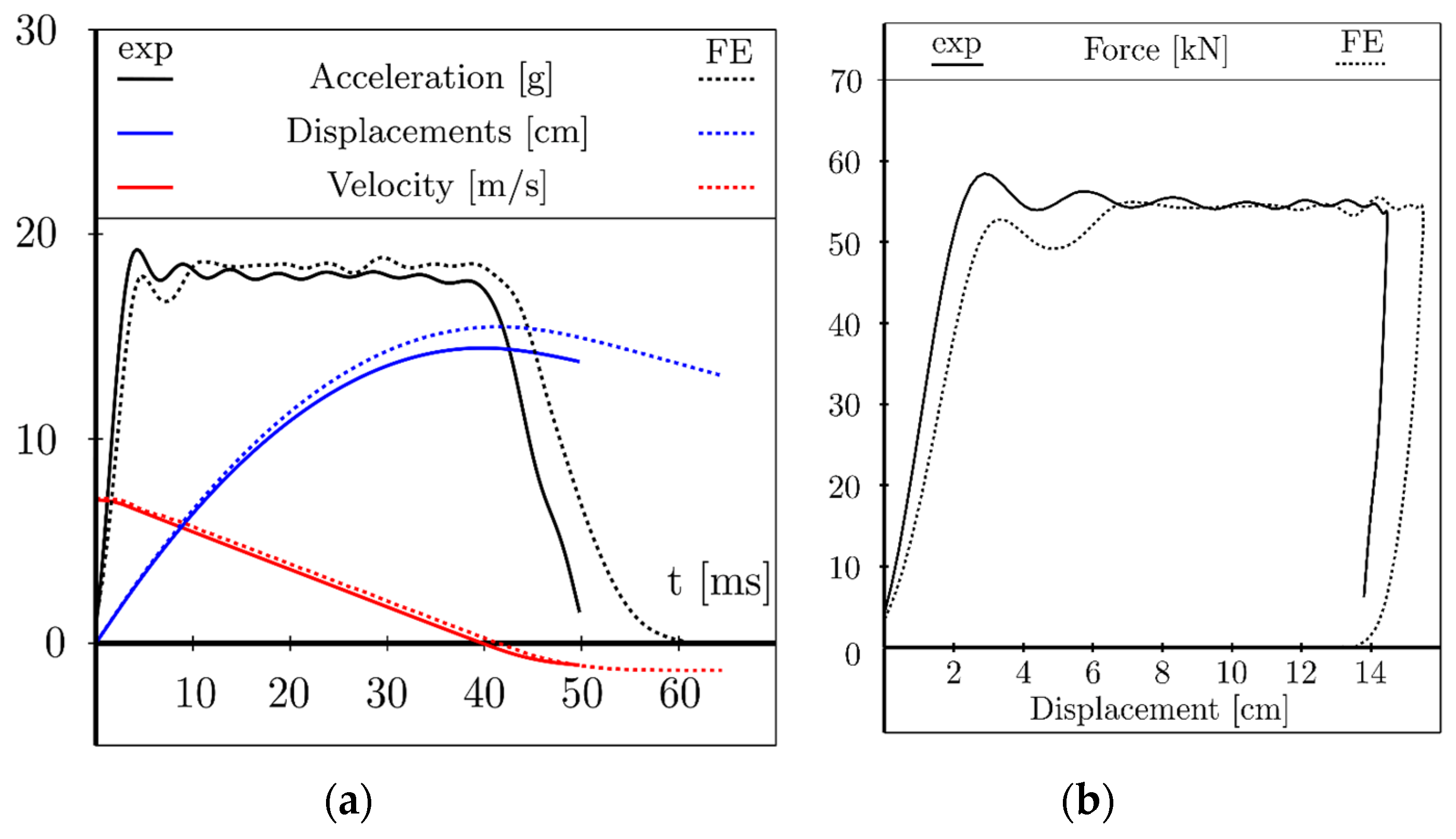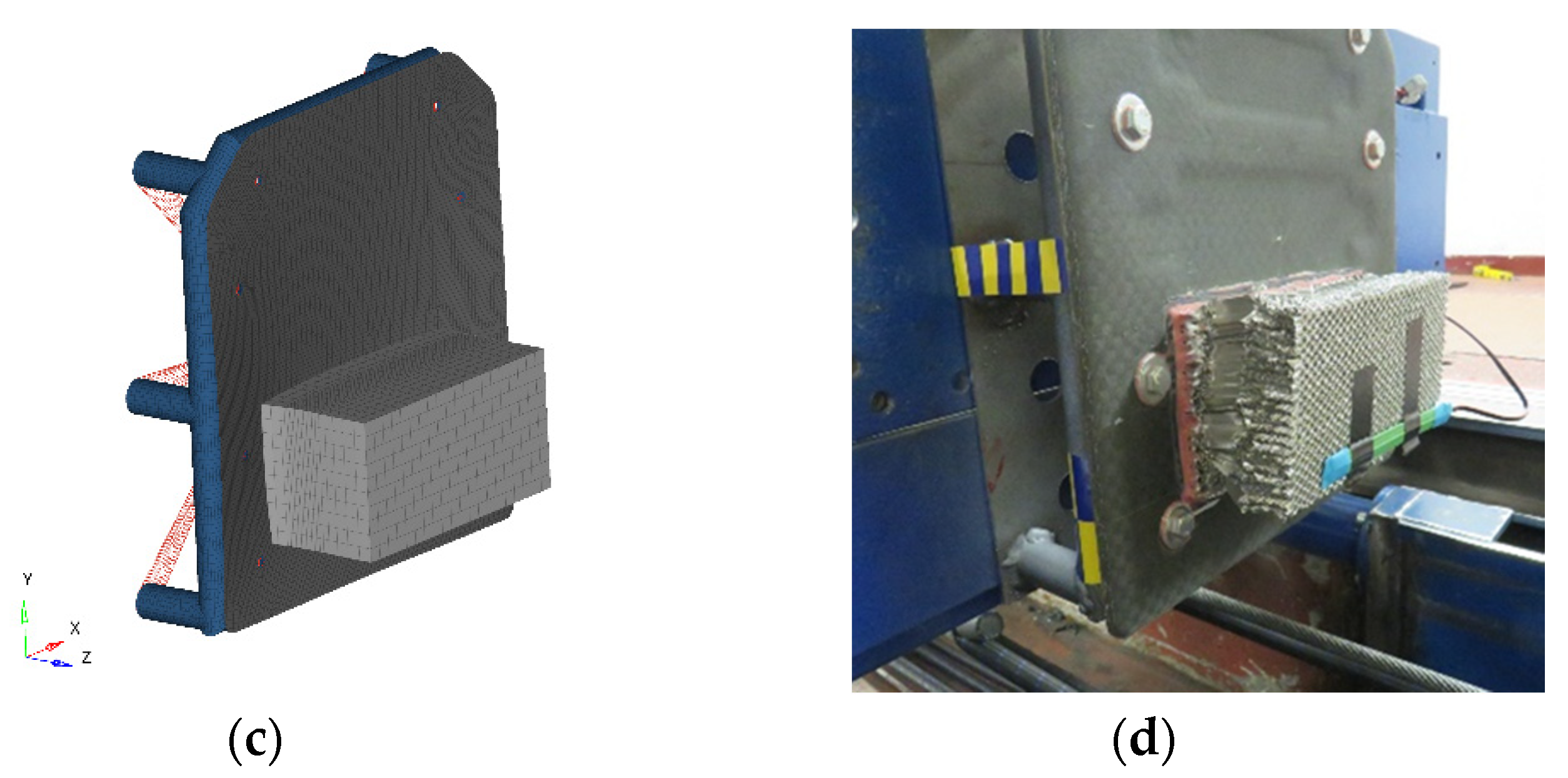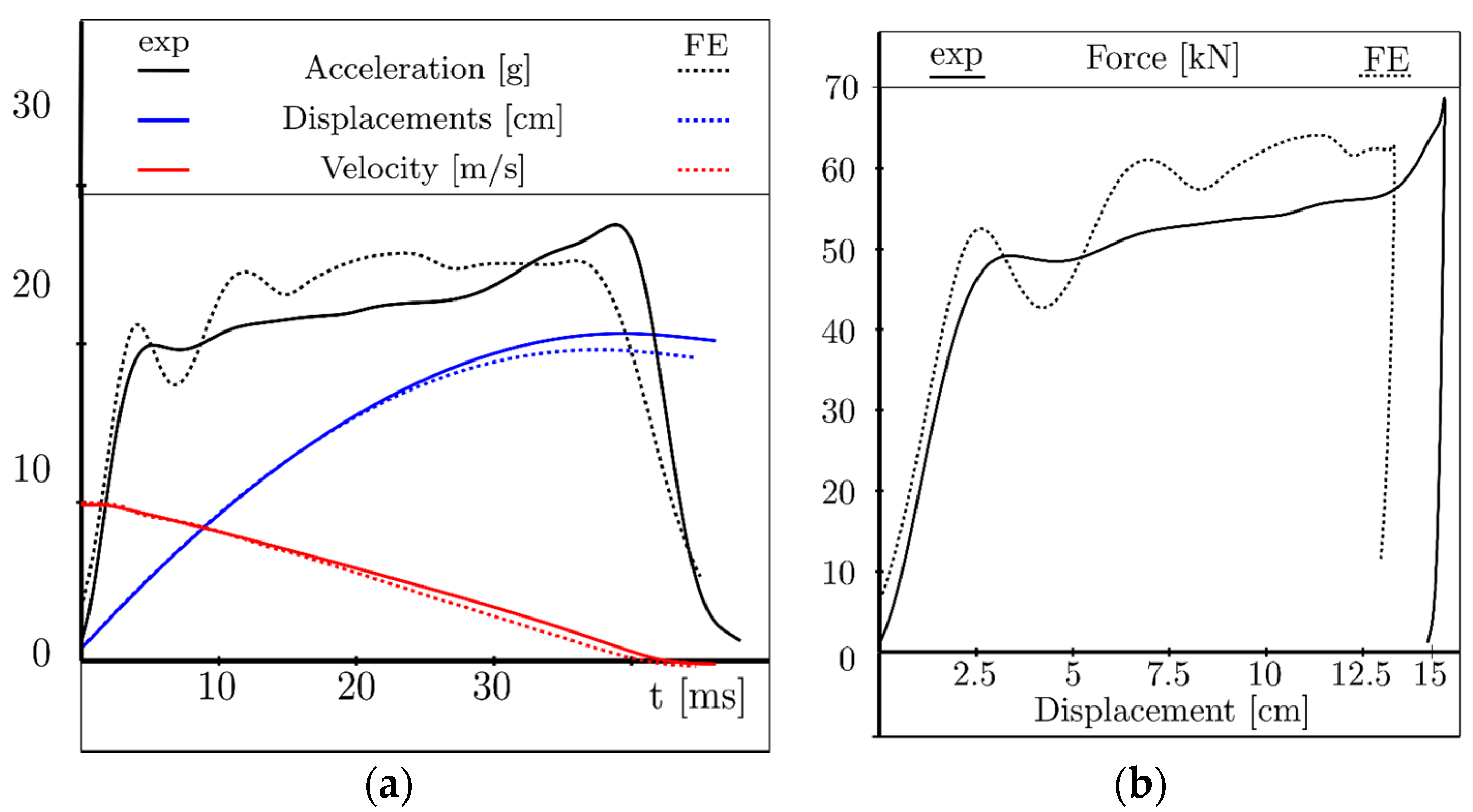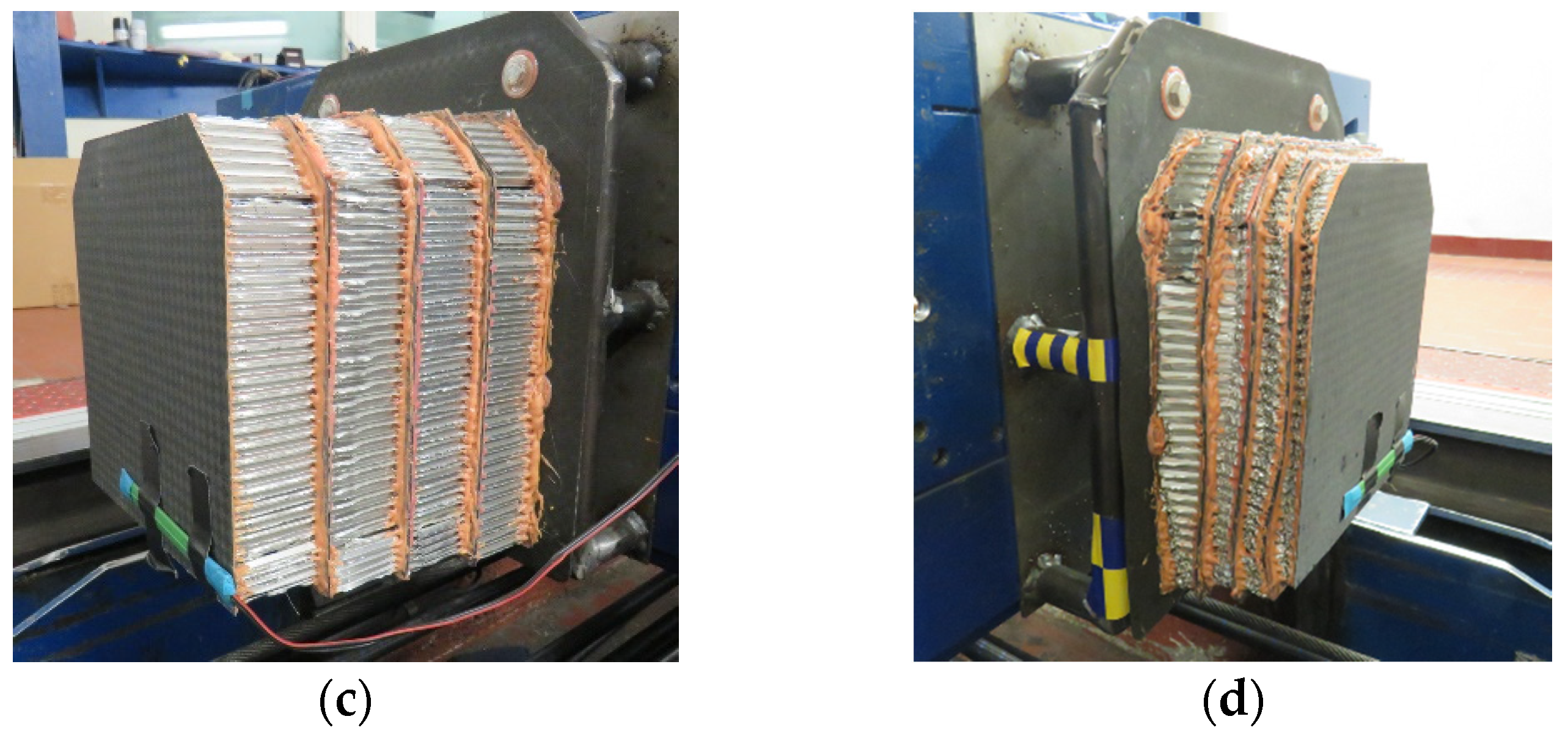2.2. Preliminary Analysis
The first step was to identify the requirements of the impact attenuator system. All of the features of the new design constraints were analyzed in terms of compliance with the rules, costs, and performance and defined as the ratio between the absorbed energy and the mass of the attenuator. Respecting the rules of the competition was clearly mandatory, while the performance and costs needed to be maximized and minimized, respectively.
The rules prescribe that the impact attenuator system be composed of two main components: the impact attenuator (IA) and the anti-intrusion plate (AIP). The system must be properly mounted onto the bulkhead at the front of the chassis. The rules establish the minimum dimensions for the IA and the performance targets in terms of deceleration, maximum deflection of the system, and absorbed energy (as described in
Table 1). The AIP must protect the driver’s feet by avoiding excessive intrusion at the front of the chassis. The rules also establish which materials are acceptable for the AIP. All of these requirements are mandatory for the IA system to be admitted to the competition.
Aside from the regulations, the first aim is to maximize the performance of the system. Weight reduction is a milestone in the design and development of a race car, as a lower weight guarantees a competitive advantage, and the passive safety systems are not excluded. The aim of this paper was to maximize the specific energy absorption (SEA) of the impact attenuator system. SEA is the energy absorbed during the impact per unit mass.
Another non-secondary aim is containing the costs of the final product. Therefore, the materials and the manufacturing processes need to be chosen carefully.
FSAE teams adopt different layouts and materials for their impact attenuator system. Despite the different configurations, the AIP is usually made of CFRPs. Three of the most popular layouts of the IA were considered in the initial phase of the design development, as shown in
Figure 2. All these possible solutions were compared considering the requirements previously mentioned.
The first IA (
Figure 2a) was a truncated pyramid made of several layers of a homogeneous high-density polymeric foam. FSAE proposes this as a standard design for its competitions. Thus, this design fully complies with the regulations. However, this solution has several drawbacks. First, it is shaped like a pyramid, so, as the impact proceeds, it touches the wall with a larger and larger area. As the response of the foam is dependent on its relative density [
18], the response of the wall increases as the IA crushes into it. A more efficient way to manage the impact is to keep the wall response constant throughout the impact. Second, while the foam is crushed, the stresses on the AIP surface are at their maximum at the center of the plate. This stress distribution requires a strong AIP to contain its maximum deflection in a frontal crash.
The need for a strong structural AIP is due to the geometry of the front bulkhead (
Figure 3a). This section has a frontal opening, which is used for maintenance (i.e., adjustments of the pedal set). To reduce the structural mission of the AIP, the load paths need to be directed toward the stiffest and most resistant zone of the bulkhead (i.e., the external edge). With this setup of the IA, the center of the AIP would be unloaded during a frontal crash, and its weight could be reduced considerably.
An example of this setup is the thin-walled pyramidal IA (
Figure 2b). The choice of the material is delegated to the team, and some FSAE [
27,
28] and F1 teams have designed a CFRP pyramidal IA [
23]. CFRPs present the highest performance in terms of absorbed energy-to-weight ratio. However, the materials and manufacturing processes involved have high financial costs. Herein, a truncated pyramid-shaped IA (
Figure 2b) was investigated and obtained by bending and welding three aluminum plates with a thickness of 2 mm. This IA was a fraction of the cost of its CFRP counterpart because of its simple technological process.
The weight of the IA may be reduced considering an aluminum honeycomb (
Figure 2c). A hexagonal honeycomb was chosen because of its superior energy-absorption properties among all the other honeycombs. The honeycomb IA has a simple geometry and can be designed according to the minimum dimensions established by the competition rules [
29]. Nevertheless, the AIP needs to have a high level of stiffness, strength, and therefore weight, in order to respect the rules of the competition. In fact, when the IA system impacts a wall, the load paths are directed toward the center of the AIP.
A third IA, shown in
Figure 3b, was also developed in this study. It integrates the advantages of the two previous designs: hollow geometry of the thin-walled aluminum pyramid absorber, orienting the load paths to the stiffer zone of the bulkhead; and the high specific energy absorption and low weight of the aluminum.
The energy absorber was composed of four aluminum honeycomb layers, each with a thickness of 50 mm. The cross-sectional area of the layers was hollow and varied on the longitudinal direction to guide the load paths to the structural members of the bulkhead. Four CFRP plates were glued to the honeycomb layers to guarantee their proper folding. Finally, the IA was glued to the CFRP AIP, which was bolted to the bulkhead of the CFRP monocoque (
Figure 3a).
To the authors’ knowledge, an IA like the one shown in
Figure 3b has never been previously presented. In this work, the hybrid IA was dimensioned, simulated, and tested for validation under the FSAE rules. Large use of the finite element (FE) methods was made to obtain a predictive numerical model before the actual impact testing.
2.4. Bulkhead Structural Equivalence
The experimental crash test was performed by mounting the IAs on the front test bulkhead made with steel tubes and plates. Since the FSAE vehicle chassis is a CFRP monocoque, the structural equivalence needs to be proven between the actual bulkhead and the steel test bulkhead.
The steel test bulkhead was built according to T.2.5.1 in [
29]. Six longitudinal tubes were joined to a hexagonal frame made of welded tubes. A steel plate was then welded to the front hexagonal frame. This plate was used to mount the IAs onto the test bulkhead.
The tubes had an outer diameter of 24 mm and a wall thickness of 1.6 mm. The length of the longitudinal tubes was chosen to guarantee a 50 mm rearward clearance. The steel plate at the front of the test bulkhead had a thickness of 1.50 mm, as prescribed by the rules. The geometry of the steel plate was exactly the same as the bulkhead of the CFRP monocoque prototype, so the IAs could be mounted with the same mounting system either on the monocoque or on the test bulkhead.
The front bulkhead of the race car prototype was a simple sandwich panel, in which two CFRP laminates with a thickness of 1.61 mm were separated by a honeycomb core with a thickness of 19.5 mm. This frontal sandwich panel was supported from its back by the panels of the primary structure.
Table 3 shows the main dimensions of the two bulkhead structures as well as the Young’s modulus and shear strength of the materials involved in the two structures. The mechanical properties of the CFRP laminates (
EFront,
EBack, and UTS
CFRP) were obtained with experimental tests performed by the FSAE team, while the homologous properties of the steel were suggested by the rules [
29].
The rules prescribe that in the structural equivalence, the two bulkhead structures should be treated like two flat panels. The proof of structural equivalence consists of evaluating the flexural modulus (
EI) of the two panels subjected to a bending around their neural axes. The section under exam is the A–A section represented in
Figure 4a.
For both the steel and the CFRP bulkhead, the critical section has two symmetrical areas working in parallel, thus the
EI of the section can be obtained by doubling the
EI of one half of that section.
Figure 4b,c show the two sections, highlighting the n–n axes, around which the moments of inertia were calculated. For the CFRP structure, the contribution of the honeycomb core was neglected.
Considering the geometrical data given in
Figure 4b,c, the two flexural moments are:
The steel and the CFRP bulkhead structures must also have the same strength. This time, the equivalence was proven on the perimeter shear strength (
). PSS is the longitudinal force needed to cause a shear rupture on the frontal outer skin of the front bulkhead.
is calculated by multiplying the shear strength of the outer shell by its minimum transversal area. The shear strength of the CFRP front laminate (
Table 3) was determined with an experimental shear test, performed by the FSAE team according to the prescriptions given in [
29]. Once again, the A–A section in
Figure 4a was considered as the critical cross-section to calculate the PSS. The
of the CFRP lamina of the chassis must be higher or equal to the
of the steel plate of the test bulkhead. Equations (9)–(11) show that the bulkhead and the test bulkhead are equivalent.
2.5. Material Characterization
The following design phase concerns the creation of three finite element (FE) models of the three impact attenuators under examination. The FE models were used to give a numerical prediction of the crash tests on the three IA designs before the actual impact tests. Therefore, the elastic and plastic properties of the materials involved must be carefully assessed.
The AIPs of the three IAs were modeled as a single CFRP laminate. A T700 prepreg fabric was employed for all AIPs, adopting a suitable stacking sequence according to the structural requirements. The mechanical properties of the composite were obtained with an experimental characterization, which included tensile tests, compressive tests, in-plane and out-of-plane shear tests, and a low-velocity impact test. All tests followed their relative ASTM standard. The elastic properties resulting from the experimental tests were in close agreement with the corresponding data given in the manufacturer’s data sheet. The crash survivability (CRASURV) criterion was applied to determine the material’s failure, and all the relative parameters were obtained from the results of the experimental tests. More details on the mechanical properties and the failure model are shown in
Appendix A.1.
A standard steel alloy was adopted to model the bolts and the parts of the front test bulkhead. The plastic behavior was modeled with the Johnson–Cook model; in this case, the effects of the strain rate on the plastic behavior was neglected.
An experimental campaign was performed to derive the elastic and plastic behavior of the honeycomb material under compression. Six samples were obtained from a hexagonal aluminum honeycomb with a cell size of 4.8 mm and a shell thickness of 0.0508 mm (see also
Table 2). Each specimen extended by 50 mm in the out-of-plane direction, and 140 mm and 19.5 mm in the two in-plane directions.
The samples were tested with an Instron
® 5567 universal testing machine (Instron, Norwood, MA, USA) (
Figure 5) mounting a 30 kN load cell. The tests were performed with a constant crossbar speed of 1 mm/min, leading to a constant strain rate of 3.33 × 10
−4 s
−1.
The resulting stress–strain curve was in close agreement with the theory [
18]. There are three separate zones: namely the initial linear elastic zone, intermediate plateau zone, and final stress densification zone (
Figure 6a). The IA design aims to prevent the densification of the material in order to monitor the average force during the impact event.
The results of the experimental tests were exploited to correlate the elasto-plastic behavior of the 5052 aluminum alloy of which the honeycomb was made. The experimental test was reproduced with a FE simulation. The FE model replicated the honeycomb geometry in detail.
The detailed honeycomb model was modeled with 215,500 four-node quadrilateral Mindlin shell elements with a size of 0.2 mm. The mesh size was chosen to seize the local folding mechanisms of the honeycomb cells. The thickness of the elements is in line with the actual foil. The elements at the junction of two foils were doubled in thickness. The honeycomb was put on a rigid plane and compressed with a second rigid plane, moving with a constant velocity. Friction between the plates and the honeycomb were considered by adopting a static Coulomb friction coefficient of 0.6.
The relation between the plastic stress (
) and plastic strain (
) of the aluminum Al5052 was modeled by the Cowper–Symonds law:
A,
B, and
n were adjusted to correlate the crushing response of the FE model with the experimental data (further details are in
Appendix A.2). Particular attention was put in correlating the average crushing force (
Fave) of the honeycomb, as this property has great importance in the honeycomb’s energy absorption.
Figure 6a compares the two stress–strain curves after the correlation, the average force resulting from the numerical simulation was 2.01 percent above the average experimental curve.
In this paper, the dynamic response of the 5052 aluminum was not addressed. An extensive characterization of aluminum alloys under impact loading at various speeds was presented by [
11,
12,
13]. The strain rate sensitivity coefficient (
C) and the reference strain rate (
) proposed in [
12] were adopted in this paper. After the characterization on the quasi-static compression test, the FE simulation of the compression test was repeated adopting five different velocities to the moving plane. The resulting stress–strain curves are shown in
Figure 6b. Increasing the strain rate (
) from 20 s
−1 to 140 s
−1 mm/s increased
Fave by 15.6 percent. This result is coherent with the experimental findings obtained by Xu et al. [
9]. The simulation also showed a decrease of 10.60 percent of the average force when decreasing the strain rate from 35 s
−1, which is the typical strain rate found at the beginning of the impact tests, and to 3.33 × 10
−4 s
−1. This is in line with the penalization coefficient we chose in the first IA dimensioning.
This modeling approach involved a long simulation time caused by the high number of elements. Therefore, this honeycomb model was not used to model the real impact attenuators.
A homogenization technique was adopted to simplify the geometry and reduce computational effort. The sample with the homogenized material was modeled with 7830 fully-integrated eight-node hexahedral elements, with an average size of 2.75 mm. The homogenized elastic and plastic properties were assumed as being orthotropic.
The out-of-plane compressive behavior of the material is determined by defining five piece-wise stress-strain laws, corresponding to five strain rates. The response of the honeycomb under a strain rate between two of these five strain rates is obtained by interpolating the values of the curves relative to the two strain rates.
The five strain rates corresponded to the strain rates of the quasi-static compression tests and the numerical simulations made with the previous model. The stress–strain laws were shaped to correlate the results from the experimental tests and the numerical simulations.
Figure 6b shows a comparison between the responses of the two numerical models during two compression tests. Once again, the main focus was put into correlating
Fave, and the homogenized honeycomb presented a maximum relative error of 2.16 percent (
Table 4). Further details on the material modeling and results are shown in
Appendix A.3.
The FE models were correlated with the experimental results as shown in
Figure 7. Altair
® Hypermesh was used to set up the FE models, while Altair
® Radioss was used to perform the simulations.
The homogenized material substantially reduced the computational effort of the simulation, as this time, the computational time was negligible if compared to the time spent to simulate the same test on the detailed model. The homogenized material did not seize the folding mechanisms of the foil, but the global collapse of the structure was coherent with the collapse we observed in the detailed model (see
Figure 7a,b). Furthermore, the results presented good accordance with the experimental parameters of interest. The homogenization technique was thus adopted for the non-linear FE models developed to mimic the crash test on the complete IA models.
2.6. Finite Element (FE) Simulations
The materials and the equivalent honeycomb material were used to model the IAs. The models are shown in
Figure 8.
The three IAs were mounted on the same steel test bulkhead. The test bulkhead was modeled with 26,602 four-node quadrilateral elements with an average size of 3 mm. A standard steel alloy was assigned to these elements. Eight mounting bolts, modeled with line elements and RBE2 links, connected the IAs to the test bulkhead. The sledge was modeled with a concentrated mass connected to the test bulkhead with a RBE2 link. The sum of the absorber, the test bulkhead, and the concentrated mass was 300 kg in all cases.
The AIP was modeled with 12,385 quadrilateral Mindlin plate elements with an average size of 3 mm. The thickness of the plate varied among the three IAs. The CFRP laminates were modeled stacking a combination of T700 prepreg fabrics, which were oriented at 0 and 45 degrees with respect to the vertical direction.
The AIPs were designed with the help of numerical optimization methods. The framework presented by Lo Presti et al. [
26] was followed in this paper where a free-size optimization, a size optimization, and a composite shuffle optimization were chained to identify the best performing combination of prepreg plies as well as their arrangement in each of the three AIPs.
The aluminum hollow truncated pyramid absorber (
Figure 8a) was modeled with 28,107 four-node shell elements. The average mesh size of the elements was 3 mm, while the shell had a thickness of 2 mm. The back plate welded at the base of the pyramid was used to mount the IA to the AIP. The welding seam was modeled by collapsing between the node of the pyramid and the back plate. The pyramid itself was made of two shells welded together. This time, the modeling of the welding seam influenced the component’s stiffness. Rotondella et al. [
31] modeled the welding seams with eight-node hexahedral elements, connected with rigid links to the connected structures. Herein, the welding seams were modeled with four-node shell elements, sharing the nodes with the elements on the two shells. The thickness of these elements is coherent with the actual welding seam. The material employed was the same 5052 aluminum of which the hollow pyramid is made. The resistance of the welding seam was penalized according to the results reported in [
32] for TIG welding of aluminum alloys. The corners at the top of the pyramid were incised to trigger the deformation at the frontal part of the attenuator. The same incisions were made on the IA prototype. The AIP consisted of three plies of T700 prepreg fabrics. The contact between the mounting plate and the AIP as well as the self-contact in the IA were modeled with Coulomb friction.
The homogenized honeycomb material was introduced to model the honeycomb crash-box absorber in
Figure 8b. The AIP had a variable thickness across its area. The maximum thickness was 5.58 mm, corresponding to 18 plies of T700 fabric with a thickness of 0.31 mm. The maximum thickness was found at the glued connection between the AIP and the honeycomb, and around the bolts. A minimum thickness of 1.86 mm was found in the center-top region of the AIP. The honeycomb was discretized in 208,542 elements of the same type and size of the elements of the sample in
Section 2.5. It was glued to the AIP, and the connection was modeled with a non-sliding contact interface between the two components.
The hybrid IA is shown in
Figure 8c. As with the honeycomb crash absorber, its numerical model included the homogenized honeycomb material, which was discretized in 186,665 elements, the same as that for the honeycomb crash-box. The honeycomb layers were glued to the anti-intrusion plate and to the intermediate CFRP laminates. The laminates were discretized in 11,596 four-node quadrilateral elements adopting Mindlin shell theory. Each of the laminates was composed of six fabric plies, and had a total thickness of 2 mm. The AIP had a maximum thickness of 3.1 mm (10 plies of T700), located around the bolts, and where the fourth layer of the IA was glued. The minimum thickness was 1 mm (3 plies) and was found in the middle of the AIP.
The load cases simulated the impact test defined in
Section 2.1. The impactors were pushed toward a rigid wall with an initial speed of 7 m/s.
The node at which the mass of the sledge was concentrated was monitored during the simulation. Data on the position, velocity, and acceleration of such node were extracted. The acceleration curve was then filtered using a Channel Filter Class CFC 60 low-pass filter (100 Hz) following the regulation SAE-J211 and checked for its maximum peak and average value. The displacement and velocity curves were left unfiltered and kept for a comparison with the results of the impact tests.
The results of the virtual impact tests are discussed in
Section 3, the three IAs fully satisfying the prescribed requirements. Three prototypes were then produced replicating the designs illustrated thus far.
Table 5 summarizes the masses of the three IAs and the CFRP plies involved in each AIP.


